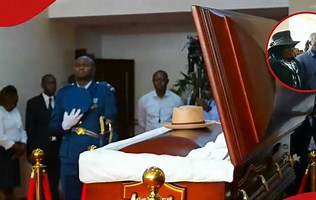
NAIROBI.The ongoing mourning of former Kenyan Prime Minister Raila Odinga has taken a new twist with some Kenyans petitioning court, challenging the government’s burial arrangements on cultural and constitutional grounds.
The petition, filed by Michael Onyango Otieno before the Constitutional and Human Rights Division of the Milimani Law Courts of the High Court of Kenya , cites the Attorney General, the National Committee on the State Funeral, several cabinet secretaries, and the family of the late Odinga among 13 respondents. The Luo Council of Elders is listed as an interested party.
Otieno argues that the state’s burial plan fails to honor Odinga’s deep adherence to Luo customs, particularly the traditional rites of “tero yuak” — an essential aspect of mourning and interment among the Luo people.
The petitioner contends that Odinga, who was crowned a Luo warrior in 2020, should be sent off “with an amplitude that befits his legacy and cultural stature” rather than under a strict state timeline.
“To inter the body of the late Rt. Hon. Raila Amolo Odinga’s caliber so quickly denies the Luo community an opportunity to give him a befitting sendoff which he religiously adored during his 80 years of life,” the petition reads in part.
The document further warns that burying Odinga within 72 hours of his death, a timeline allegedly proposed by some planners, would “scramble the customary choreography of grief” and contravene Article 44 of Kenya’s Constitution, which protects cultural expression and community identity.
The petition compares Odinga’s stature to that of the late Presidents Jomo Kenyatta and Mwai Kibaki, and reformist Tom Mboya, all of whom were accorded elaborate state and traditional sendoffs.
“Men of the deceased’s stature were sent off with an amplitude that became part of their legacy. To bury him quickly is to reject the theatre,” the document states.
Meanwhile, tensions flared at Kasarani Stadium on Friday morning, where a section of Odinga’s supporters gathered ahead of the planned state funeral service.
Police fired teargas to disperse rowdy mourners who attempted to force their way past security barricades, chanting slogans in honor of the opposition icon.
Authorities later confirmed that the disruption was contained and the stadium secured before dignitaries arrived for the service.
Odinga’s body, flown home aboard a special Kenyan Air Force aircraft from India, has since been moved to Parliament Buildings for public viewing.
The burial remains scheduled for Sunday, October 19, in Bondo, Siaya County, under the Anglican Church of Kenya (ACK) rites.
However, the pending court case may test the balance between state protocol and cultural autonomy, as Kenya bids farewell to one of its most consequential political figures, a man whose life bridged the struggles of independence, democracy, and Pan-Africanism.